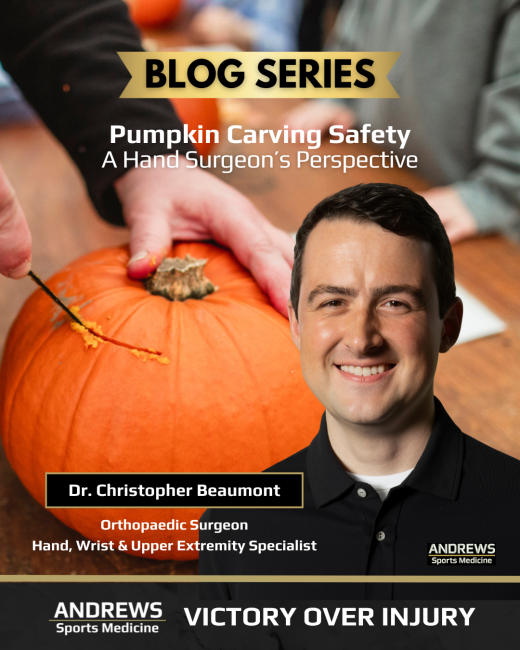
Pumpkin Carving Safety: A Hand Surgeon’s Perspective
By: Dr. Christopher Beaumont - Hand, Wrist & Upper Extremity Orthopaedic Surgeon
A Fun Tradition That Can Lead to Serious Injuries
Every Halloween season, my partner, Dr. Kathleen McKeon, and I see several patients—both adults and children—come into our office with serious hand and finger injuries from carving pumpkins.
It’s one of those traditions that seems harmless enough, but each year, we treat deep cuts, tendon injuries, and even nerve damage that could have been prevented with just a few precautions.
As orthopedic surgeons who specialize in the hand, wrist, and upper extremity, we always remind our patients that the most common pumpkin carving injuries are lacerations—deep cuts to the palm and fingers.
Many of these are severe enough to affect tendons and nerves, which can lead to lasting complications if not treated promptly.
Why Pumpkin Carving Injuries Happen
The biggest factor behind pumpkin carving injuries is inexperience. Most people only carve pumpkins once a year, so they’re not familiar with the motions or the resistance of a thick pumpkin rind.
These injuries often occur when a knife slips or gives way unexpectedly. Sometimes it’s because your hand is in the wrong place when the blade finally breaks through the pumpkin’s skin.
Other times, the knife slides out the opposite side—where your other hand is holding the pumpkin steady.
Safety Tips to Prevent Hand Injuries
There are a few simple steps we always recommend to make carving safer:
- Carve in a clean, dry, well-lit area.
- Wash and thoroughly dry your tools, pumpkin, and hands before you begin — moisture causes slipping.
- Never cut toward yourself; always keep the blade pointed away from your hands and fingers.
- Take your time. Rushing is one of the easiest ways to get hurt.
- Supervise children closely.
- Avoid using sharp knives while drinking alcohol — it’s never worth the risk.
What to Do If You Get Cut
Puncture wounds are also fairly common when carving pumpkins. Even though they may look small, they can be deceptively deep and still damage nerves or tendons. Don’t ignore them.
For either lacerations or puncture wounds, start with basic first aid:
- Clean the wound gently with warm, soapy water.
- Apply a dry dressing such as a bandage or non-stick gauze.
- Avoid ointments like Neosporin — they can sometimes trap bacteria inside an open wound.
Bleeding should stop after 5–10 minutes of direct pressure. If it doesn’t, or if you can’t control the bleeding after an hour, go to the emergency room. Likewise, if you notice numbness, tingling, or limited motion after a cut, seek medical attention right away — those are signs of tendon or nerve injury that shouldn’t wait.
Keeping Pumpkin Carving Fun — and Safe
Pumpkin carving is a fun seasonal activity, and with a few precautions, it can stay that way. Take your time, use the right tools, and keep safety in mind. Your hands will thank you for it!
Dr. Christopher Beaumont – Hand, Wrist & Upper Extremity Orthopaedic Surgeon
Dr. Christopher Beaumont is a board-certified, fellowship-trained orthopaedic surgeon at Andrews Sports Medicine in Birmingham, Alabama, specializing in the hand, wrist, and upper extremity. He provides expert care for patients of all ages — from athletes recovering from sports-related injuries to individuals experiencing hand and wrist pain from everyday activities.
Dr. Beaumont partners with Dr. Kathleen McKeon as part of Andrews Sports Medicine’s hand and wrist team, offering advanced, compassionate care to help patients regain strength, function, and mobility. His approach combines the latest surgical and non-surgical techniques with a focus on helping each patient achieve their own Victory Over Injury.
If you’ve experienced any of these injuries or symptoms, schedule an appointment with Dr. Beaumont and our team today at 205-939-3699 or request an online appointment.
For more information about hand and upper extremity care, visit our Hand & Wrist Team page or contact us at AndrewsSportsMedicine.com.







